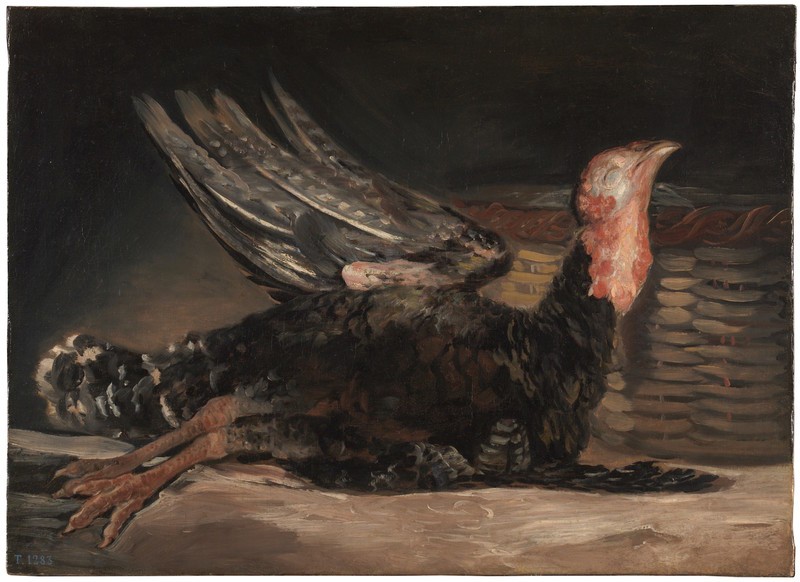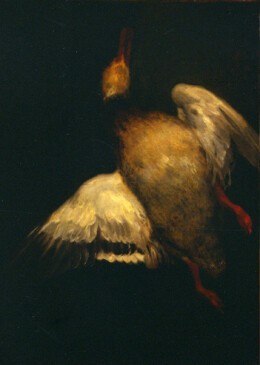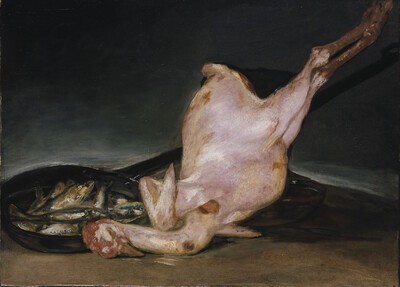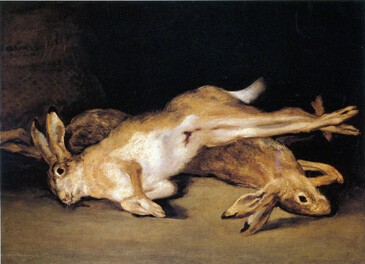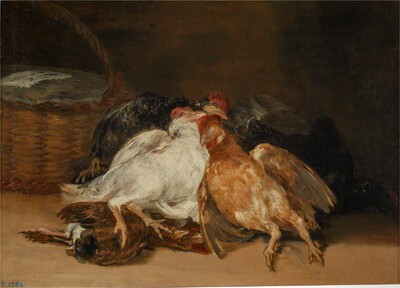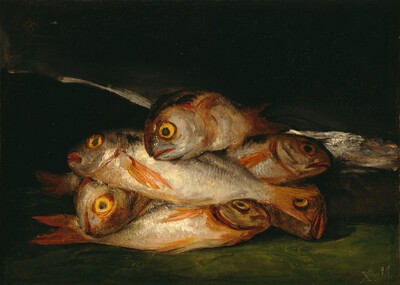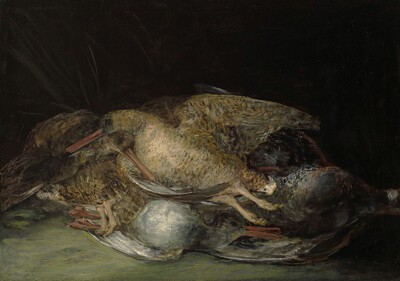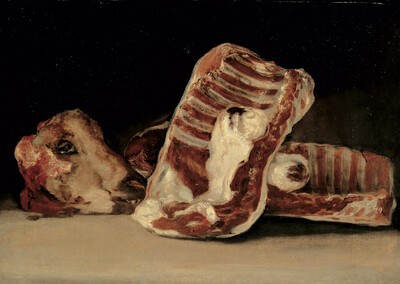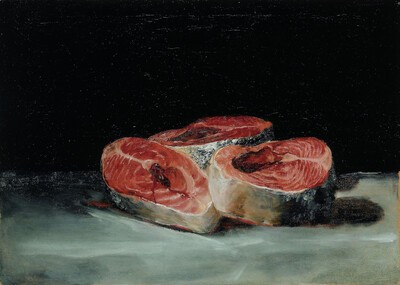- Cronología
- 1808 - 1812
- Ubicación
- The Prado National Museum. Madrid, Madrid, Spain
- Dimensiones
- 45 x 63 cm
- Técnica y soporte
- Oil on canvas
- Reconocimiento de la autoría de Goya
- Documented work
- Titular
- El Prado National Museum
- Ficha: realización/revisión
- 20 Apr 2010 / 15 Jun 2023
- Inventario
- (P00751)
- Otros títulos:
-
Unskinned Dead Turkey (Pavo muerto sin pelar)
Dead Turkey and Basket (Pavo muerto y cesta)
Goya (in the middle of the foreground, painted vertically).
For more information, see Pieces of Lamb.
Javier Goya inherited this series of still lifes from his father, and in turn left them to his own son, Mariano. When he was unable to repay a loan made to him by the Count of Yumuri, Carabanchel, Mariano gave this set of paintings as security, and in the end the works became the property of the count. When the Count of Yumuri died in 1865 the series of still lifes was sold. Today these works are scattered between different museums and institutions around the world, and some of the paintings have now been lost.
This canvas was acquired for the Prado Museum by the Spanish Ministry of Development on 20 March 1900, with the work's owner, Rafael García Palencia, receiving three thousand pesetas for it. The day after it was purchased, the painting entered the collection of the Madrid museum, which mentions it for the first time in the 1900 edition of its catalogue.
In this still life Goya has painted a dead turkey on top of a table. Its head rests against a wicker basket, the only spatial reference found in the painting. The stripped-down nature of the setting in which the animal has been placed avoids any distractions and makes the turkey itself the unquestionable protagonist of the work.
The Aragonese artist has used a fairly limited colour palette. The turkey's body is the same colour as the background, with just a few brushstrokes of ochre, white and red added to suggest a sense of volume. The bottom of the turkey is delimited with white and ochre, whilst a purplish red is used for the animal's head.
The turkey is lying with its wings outstretched and its legs held rigid, most likely indicating that it died only recently, in a posture which contributes to the drama of the scene.
For more information, see Pieces of Lamb.
-
El arte de GoyaMuseo de Arte Occidental de TokioTokyo1971from 16th 1971 to January 23th 1972. Exhibited also at the Kyoto Municipal Museum of Art, January 29th to March 15th 1972.cat. 103
-
GoyaPalacio de PedralbesBarcelona1977from April 12th to June 30th 1977cat. 38
-
De El Greco a GoyaPalacio de Bellas ArtesMexico D.F.1978November-December 1978cat. 41
-
Exposición de pintura españolaBelgrade1981cat. 19
-
De Greco á Picasso. Cinq siècles d’art espagnolMusée du Petit PalaisParís1987from October 10th 1987 to January 3th 1988cat. 107
-
GoyaNationalmuseumStockholm1994consultant editors Juan J. Luna and Görel Cavalli-Björkman. From October 7th 1994 to January 8th 1995cat. 34
-
El bodegón español de Velázquez a GoyaThe National GalleryLondon1995exhibition celebrated from February 22nd to May 21st 1995, curated by Peter Cherrycat. 68
-
Goya. 250 AniversarioMuseo Nacional del PradoMadrid1996consultant editor Juan J. Luna. From March 29th to June 2nd 1996cat. 133
-
Francisco de Goya: Maleri, Tegning, GrafikkNasjonalgallerietOslo1996from 10th to April 14th 1996cat. 22
-
Goya, un regard librePalais de Beaux ArtsLille1998from December 12th 1998 to March 14th 1999. Exhibited also at The Philadelphia Museum, Philadelphia, April 17th 1999 to July 11th 1999, consultant editor Arnauld Brejon de Lavergnée and Joseph J. Rishel in collaboration with Manuela B. Mena Marquéscat. 44
-
Goya en tiempos de guerraMuseo Nacional del PradoMadrid2008consultant editor Manuela B. Mena Marqués, from April 14th to July 13th 2008cat. 60
-
Goya y el Mundo ModernoMuseo de ZaragozaZaragoza2008organized by the Fundación Goya en Aragón at the Museo de Zaragoza, consultant editors Valeriano Bozal and Concepción Lomba Serrano. From December 18th 2008 to March 22nd 2009cat. 60
-
Il silenzio sulla tela natura morta spagnola da Sánchez Cotán a Goya2018
-
L'œuvre peint de Goya. 4 volsParís1928-1950p. 214, cat. 177
-
Vie et ouvre de Francisco de GoyaParísOffice du livre1970p. 262, cat. 904
-
BarcelonaPolígrafa1970vol. I, p. 352, cat. 589
-
L’opera pittorica completa di GoyaMilanRizzoli1974p. 123, cat. 501
-
Francisco de Goya, 4 vols.ZaragozaCaja de Ahorros de Zaragoza, Aragón y Rioja1980-1982vol. III, p. 187
-
Goya. Arte e condizione umanaNaplesLiguori editore1990pp. 158-160, il. 141
-
El bodegón español de Velázquez a GoyaMadridEdiciones El Viso1995pp. 175, 176, 177, 180, 182 (il.) y 184,
-
Goya. 250 AniversarioMadridMuseo del Prado1996pp. 229 (il.), 404 y 405, cat. 133
-
Los mundos de Goya (1746-1828)BarcelonaLunwerg2008pp. 159-160
-
Goya en tiempos de guerraMadridMuseo Nacional del Prado2008pp. 240 y 244, cat. 60
-
Goya y el Mundo ModernoZaragozaFundación Goya en Aragón y Lunwerg2008p. 132, cat. 60
-
Sagep Arte2018
